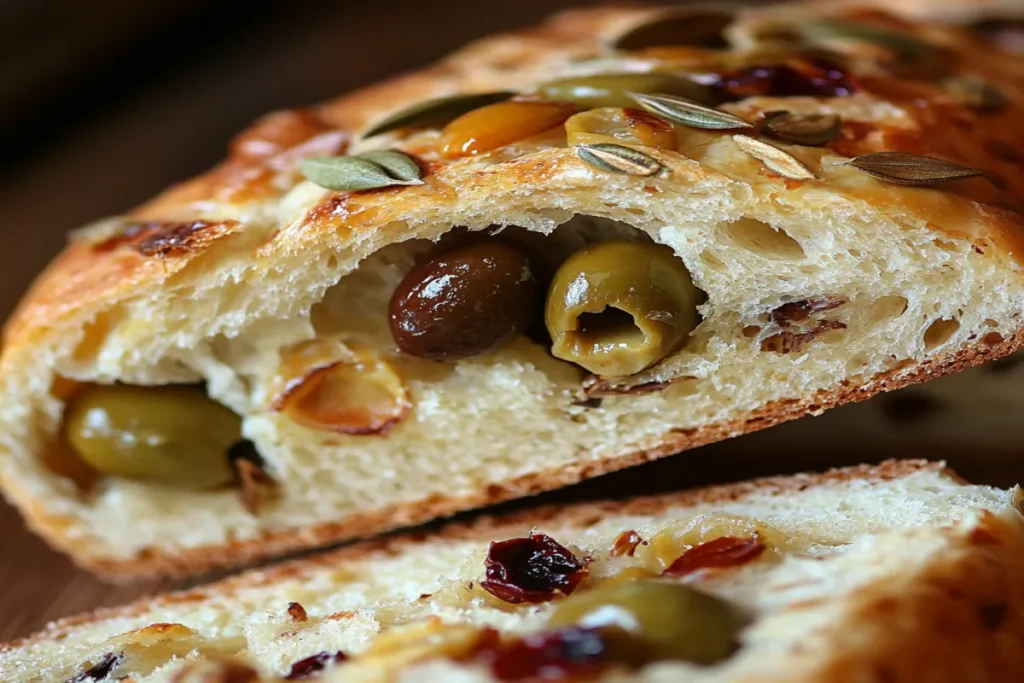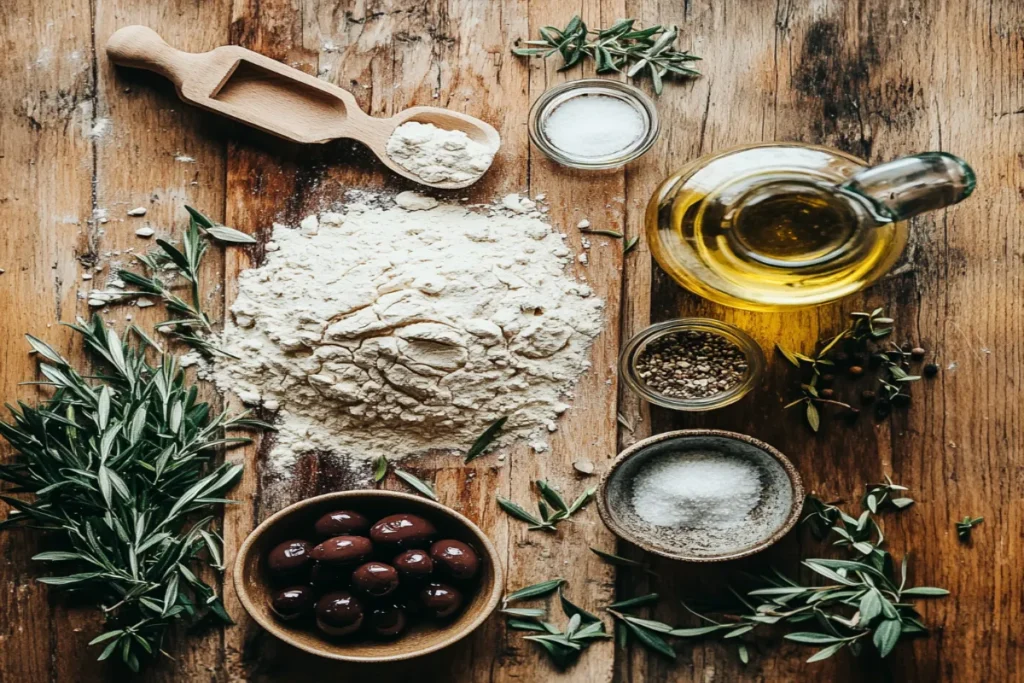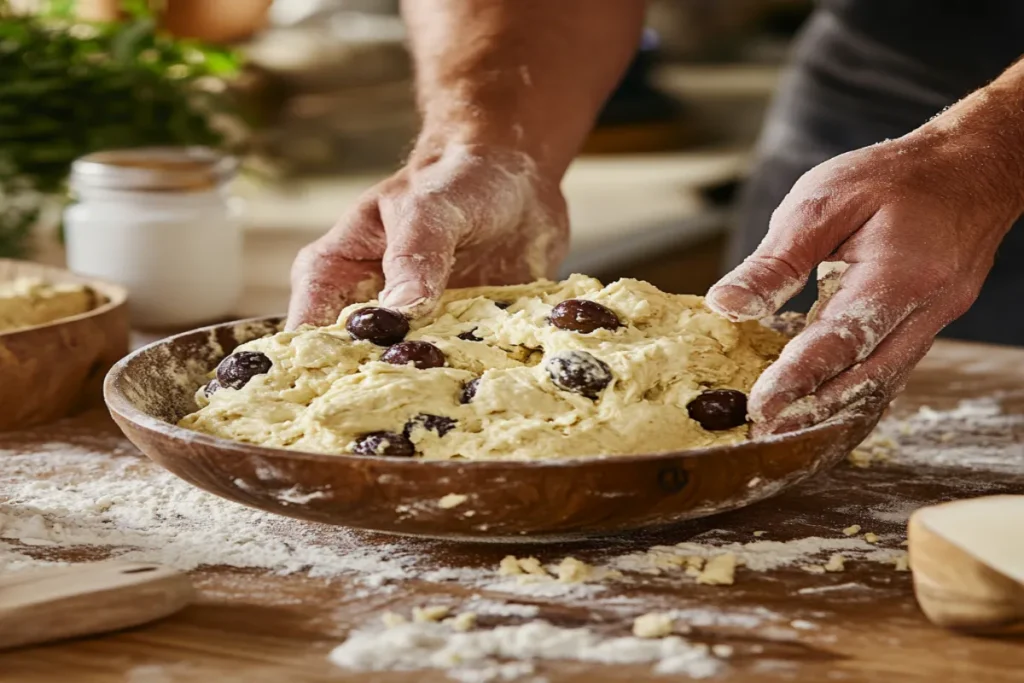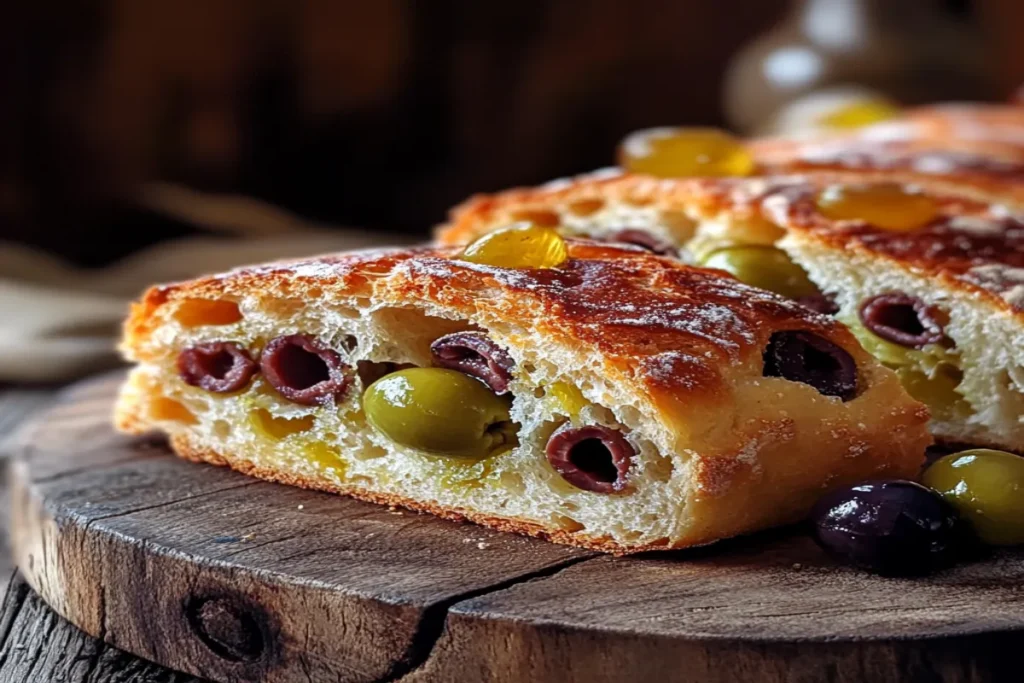Olive bread recipe is a rustic, Mediterranean-inspired loaf packed with the rich, briny flavor of olives. With its crispy crust and soft, airy interior, this bread is perfect for serving alongside soups, cheeses, or simply dipping in olive oil. Whether you’re a beginner or an experienced baker, this guide will walk you through how to make homemade olive bread that’s both flavorful and perfectly textured.
In this article, you’ll learn about:
- The best ingredients for olive bread
- Step-by-step instructions for making it at home
- Common mistakes to avoid
- Storage and pairing ideas
- Frequently asked questions about olive bread
Now, let’s dive into everything you need to know about this delicious loaf!

Table of Contents
What Is Olive Bread?
Origins and History of Olive Bread
Olive bread is a delicious, rustic loaf that has been enjoyed for centuries, particularly in Mediterranean regions. The combination of flour, yeast, water, and olives creates a bread that is both soft inside and crusty on the outside. This flavorful loaf is a staple in countries like Italy, Greece, and France, where olives are an essential part of traditional cuisine.
Print
Homemade Olive Bread – Soft, Flavorful, and Irresistibly Crusty
- Total Time: 2 hours 30 minutes
- Yield: 1 loaf (10 slices) 1x
Description
A rustic olive bread with a soft, flavorful crumb and a golden, crusty exterior—perfect for dipping, sandwiches, or enjoying warm with olive oil.
Ingredients
- 3½ cups (440g) bread flour
- 1½ tsp salt
- 1 tsp sugar (optional)
- 1 packet (2¼ tsp) active dry or instant yeast
- 1¼ cups (300ml) warm water (110°F / 43°C)
- 2 tbsp olive oil
- 1 cup pitted olives (Kalamata, Castelvetrano, or mix), chopped
- 1 tsp dried oregano or rosemary (optional)
Instructions
- Activate Yeast (if using active dry) – Mix warm water and sugar, sprinkle yeast, let sit 5–10 mins until foamy. Skip if using instant yeast.
- Mix Dough – Combine flour and salt in a bowl. Add yeast mixture (or instant yeast), olive oil, and water. Stir into a shaggy dough.
- Add Olives & Herbs – Fold in chopped olives and herbs.
- Knead – On a floured surface, knead 8–10 mins until smooth and elastic. Stand mixer: 5–6 mins with dough hook.
- First Rise – Place in greased bowl, cover, let rise 1–2 hrs (or overnight in fridge) until doubled.
- Shape – Punch down, shape into loaf, place on parchment-lined baking sheet.
- Second Rise – Cover, proof 30–45 mins while preheating oven to 450°F (230°C).
- Bake – Dust loaf with flour, score top, bake 30–35 mins until golden and crusty.
- Cool & Serve – Transfer to wire rack, cool at least 20 mins before slicing.
Notes
Rinse olives before adding to reduce saltiness. For a crispier crust, add a pan of hot water to the oven for steam. A 70/30 mix of bread flour and all-purpose gives the perfect balance of softness and chew.
- Prep Time: 20 minutes (+ 1–2 hours rise time)
- Cook Time: 30–35 minutes
- Category: Bread
- Method: Baking
- Cuisine: Mediterranean
Nutrition
- Serving Size: 1 slice
- Calories: 180
- Sugar: 0g
- Sodium: 300mg
- Fat: 5g
- Saturated Fat: 1g
- Unsaturated Fat: 4g
- Trans Fat: 0g
- Carbohydrates: 28g
- Fiber: 2g
- Protein: 5g
- Cholesterol: 0mg
- Italy: The Italian version of olive bread, known as Pane alle Olive, is often made with ciabatta or rustic sourdough. It pairs beautifully with cheeses, cured meats, and olive oil.
- France: The French enjoy Pain aux Olives, a light, airy bread with a crispy crust, often served with tapenade or cheese.
- Greece: Greek olive bread, called Eliopsomo, is enriched with extra virgin olive oil and Mediterranean herbs like oregano and thyme.
Each version of olive bread brings a unique taste and texture, but all share the rich, briny flavor of olives baked into a crusty, golden loaf.
Traditional Olive Bread Variations Around the World
While the classic olive bread recipe consists of simple ingredients, many variations enhance its flavor and texture. Some popular types include:
- Herb-Infused Olive Bread – Adding rosemary, thyme, or oregano gives the bread an extra Mediterranean touch.
- Cheesy Olive Bread – Mixing Parmesan, feta, or goat cheese into the dough creates a rich, savory loaf.
- Whole Wheat Olive Bread – A healthier version that uses whole wheat flour for added fiber and a nuttier taste.
- No-Knead Olive Bread – A slow-fermented method that enhances the flavor with minimal effort.
Whether you prefer a classic olive bread recipe or a creative variation, this homemade olive bread is a perfect choice for any meal.
Essential Ingredients for the Best Olive Bread
A perfect olive bread recipe starts with the right ingredients. Every component plays a crucial role in developing the soft interior, chewy texture, and crusty exterior that makes olive bread so irresistible. Whether you’re making a traditional Mediterranean olive bread or a creative variation, using high-quality ingredients will enhance the flavor and texture of your homemade olive bread.

Choosing the Right Flour for the Best Olive Bread Texture
Flour is the foundation of any olive bread recipe, and selecting the right type will determine the final texture of your olive bread loaf.
- Bread Flour – The best choice for a chewy, airy crumb with a strong gluten structure.
- All-Purpose Flour – Works well but produces a slightly softer olive bread compared to bread flour.
- Whole Wheat Flour – Adds a nutty depth of flavor and extra fiber but results in a denser loaf.
- Gluten-Free Flour Blend – Ideal for a gluten-free olive bread recipe, but requires xanthan gum for structure.
💡 Tip: A 70/30 mix of bread flour and all-purpose flour helps balance the chewiness and softness in your olive bread dough.
Selecting the Best Olives for Olive Bread
The olives you choose directly impact the flavor of your homemade olive bread. Some olives are mild and buttery, while others are bold and briny.
Best Olives for an Authentic Olive Bread Recipe
| Olive Type | Flavor Profile | Best For |
|---|---|---|
| Kalamata | Rich, tangy, slightly fruity | Classic Mediterranean olive bread |
| Castelvetrano | Buttery, mild, slightly sweet | Softer, less salty olive bread |
| Niçoise | Deep, earthy, slightly bitter | French-inspired olive bread |
| Manzanilla | Salty, nutty, firm texture | Spanish-style olive bread |
How to Prepare Olives for the Best Olive Bread
- Always use pitted olives for convenience.
- Rinse store-bought olives to remove excess salt and brine.
- Chop olives into halves or quarters to ensure even distribution throughout your olive bread dough.
💡 Tip: A mix of Kalamata and Castelvetrano olives gives the best balance of salty, fruity, and buttery flavors in your olive bread recipe.
The Role of Yeast and Fermentation in Olive Bread Dough
Yeast is essential for the rise, flavor, and texture of olive bread. There are two main types of yeast to choose from:
- Active Dry Yeast – Needs to be dissolved in warm water before mixing. Great for a steady rise.
- Instant Yeast – Can be mixed directly into the flour, making it easier to work with.
Slow Fermentation vs. Quick Rise for Olive Bread Dough
- Slow Fermentation (Overnight in the Fridge): Creates a deep, complex flavor and a chewy, artisan texture.
- Quick Rise (1-2 Hours at Room Temperature): Speeds up the process but results in a milder-tasting olive bread.
💡 Tip: For the best olive bread recipe, let your dough rise slowly in the fridge overnight before baking.e baking.
PART 3:How to Make Olive Bread at Home
Now that you know the essential ingredients, it’s time to put them together and bake the perfect olive bread! This olive bread recipe will guide you step by step, ensuring you get a crusty, golden exterior and a soft, airy interior with rich olive flavor in every bite. Whether you’re a beginner or an experienced baker, this homemade olive bread is easy to make and packed with Mediterranean goodness.
Step-by-Step Instructions for Olive Bread Dough Preparation
Ingredients for Homemade Olive Bread
To make the best olive bread, gather the following ingredients:
✅ 3 ½ cups (440g) bread flour (for a chewy, airy texture)
✅ 1 ½ teaspoons salt (balances flavors and controls yeast activity)
✅ 1 teaspoon sugar (optional, but helps activate the yeast)
✅ 1 packet (2 ¼ teaspoons) active dry yeast or instant yeast
✅ 1 ¼ cups (300ml) warm water (about 110°F/43°C for proper yeast activation)
✅ 2 tablespoons olive oil (adds moisture and enhances flavor)
✅ 1 cup pitted olives, chopped (Kalamata or Castelvetrano for the best flavor)
✅ 1 teaspoon dried oregano or rosemary (for a Mediterranean touch)
1. Activate the Yeast (If Using Active Dry Yeast)
- In a small bowl, combine warm water and sugar.
- Sprinkle the yeast on top and let it sit for 5-10 minutes until foamy.
- If using instant yeast, skip this step and mix it directly with the flour.

2. Mix the Dough for Olive Bread
- In a large mixing bowl, combine bread flour and salt.
- Add the yeast mixture (or instant yeast), olive oil, and warm water.
- Stir until a rough, shaggy dough forms.
3. Add Olives to the Dough
- Fold in the chopped olives and herbs.
- Be careful not to crush the olives too much, so you get a flavorful bite in every slice of olive bread.
4. Knead the Dough for the Perfect Olive Bread Texture
- Transfer the dough to a lightly floured surface and knead for 8-10 minutes until smooth and elastic.
- If using a stand mixer, knead with a dough hook on medium speed for 5-6 minutes.
Proofing the Dough for a Soft and Airy Olive Bread
5. First Rise (Bulk Fermentation)
- Place the dough in a lightly greased bowl and cover with a clean kitchen towel.
- Let it rise in a warm place for 1 to 2 hours, or until doubled in size.
- For the best olive bread flavor, let the dough ferment in the fridge overnight.
6. Shape the Dough for the Final Proofing
- Gently punch down the dough to release air.
- Shape it into a round or oval loaf and place it on a parchment-lined baking sheet.
7. Second Rise (Final Proofing for Olive Bread Dough)
- Cover the shaped dough and let it proof for 30-45 minutes while preheating the oven.
Baking Olive Bread for a Crusty and Golden Finish
8. Preheat the Oven for Perfect Olive Bread
- Preheat your oven to 450°F (230°C) for at least 30 minutes before baking.
- Place a baking tray or Dutch oven inside to heat up.
- For a crispy crust, add a small oven-safe dish filled with hot water to create steam.
9. Score and Bake the Olive Bread
- Dust the dough lightly with flour and score the top with a sharp knife.
- Transfer to the hot baking tray or Dutch oven.
- Bake for 30-35 minutes, until the crust is golden brown and crisp.
10. Cooling and Serving Homemade Olive Bread
Serve warm with olive oil, cheese, or your favorite dips for a delicious Mediterranean experience.ade olive bread! Next, we’ll explore exciting variations of olive bread to try.
Let the olive bread cool completely on a wire rack before slicing.
Variations of Olive Bread
Once you’ve mastered the classic olive bread recipe, you can explore different variations to customize the flavor and texture. From whole wheat options to cheesy stuffed loaves, these delicious twists on homemade olive bread will elevate your baking experience. Whether you want a healthier olive bread or a decadent, cheese-filled loaf, these variations will help you create the perfect olive bread for any occasion.
Whole Wheat and Multigrain Olive Bread
If you want a more nutritious version of olive bread, using whole wheat or multigrain flour is a great choice. This variation adds fiber, vitamins, and a nuttier taste to the olive bread recipe, making it both healthy and delicious.
How to Make Whole Wheat Olive Bread:
- Use 50% whole wheat flour and 50% bread flour for a balance of structure and chewiness.
- Add 2 tablespoons of honey or maple syrup to balance the slight bitterness of whole wheat.
- Mix in flaxseeds, sunflower seeds, or sesame seeds for extra nutrition and crunch.
Result: A hearty, fiber-rich whole wheat olive bread with a slightly denser texture but a wonderful nutty flavor.
Cheese-Stuffed Olive Bread with Herbs
Adding cheese and herbs takes olive bread to the next level, creating a rich, gooey, and aromatic loaf.
How to Make Cheese-Stuffed Olive Bread:
- Follow the base olive bread recipe until the shaping step.
- Roll out the dough into a rectangle and sprinkle ½ cup shredded cheese (Parmesan, feta, or mozzarella).
- Add 1 tablespoon chopped fresh herbs (rosemary, oregano, or thyme) for extra Mediterranean flavor.
- Roll the dough into a log or shape it as a loaf and bake as usual.
Result: A cheesy, flavorful olive bread loaf with gooey melted cheese in every bite.
Gluten-Free Olive Bread Recipe
For those avoiding gluten, this gluten-free olive bread is the perfect alternative while maintaining the same delicious flavors.
How to Make Gluten-Free Olive Bread:
- Use a gluten-free all-purpose flour blend (with xanthan gum for structure).
- Increase the water content slightly, as gluten-free flours absorb more moisture.
- Allow the dough to rise longer than usual to improve the texture.
Result: A soft, gluten-free olive bread that retains the rich, briny taste of olives without gluten.
Other Delicious Olive Bread Variations to Try
✔ No-Knead Olive Bread – Uses an overnight fermentation process for an effortless, rustic olive bread recipe.
✔ Spicy Olive Bread – Add red pepper flakes or chopped jalapeños for a bold, spicy kick.
✔ Black & Green Olive Bread – A mix of different olive types for a complex, layered flavor.
✔ Sourdough Olive Bread – Incorporate a sourdough starter for a tangy, chewy olive bread with deep flavor.
Now that you’ve explored different olive bread variations, let’s talk about common mistakes and how to avoid them when baking your perfect loaf!

For more delicious homemade bread recipes, check out our Deliciously Moist Banana Bread Recipe. It’s a great alternative if you’re looking for a sweet twist on homemade baking!
Common Mistakes and How to Avoid Them
Baking the perfect olive bread requires attention to detail, and even small mistakes can affect the final result. If your olive bread recipe turns out too dense, too dry, or overly salty, don’t worry! Here’s how to avoid the most common olive bread baking mistakes and ensure your homemade olive bread is always soft inside and crusty on the outside.
1. Over-Kneading or Under-Kneading the Dough
❌ The Problem:
- Over-kneading makes olive bread tough and chewy by developing too much gluten.
- Under-kneading prevents proper structure, leading to a dense, flat loaf.
✅ The Fix:
- Knead by hand for 8-10 minutes or use a stand mixer on medium speed for 5-6 minutes.
- Use the windowpane test: Stretch a small piece of dough—if it becomes thin and translucent without tearing, it’s ready.
2. Troubleshooting a Dense or Dry Olive Bread
❌ The Problem:
- The bread turns out too dense and heavy.
- The crust is too hard, while the inside is too dry.
✅ The Fix:
- Ensure your yeast is active—if it doesn’t foam during activation, discard and start fresh.
- Avoid adding too much flour—the dough should be slightly sticky but not overly dry.
- Allow for proper proofing time—let the dough rise until doubled in size for the best texture.
- For a softer crust, brush the olive bread with olive oil or butter after baking.
3. Preventing Overly Salty Olive Bread
❌ The Problem:
- The olive bread recipe results in a loaf that is too salty.
✅ The Fix:
- Rinse the olives thoroughly before adding them to the dough to remove excess brine.
- Reduce the added salt in the recipe slightly if using very salty olives like Kalamata.
- Use low-sodium olives for a milder taste.
4. Avoiding Common Baking Mistakes
| Mistake | How to Avoid It |
|---|---|
| Skipping the second proofing | Always allow the shaped dough to rise again before baking. |
| Baking at the wrong temperature | Preheat the oven to 450°F (230°C) for a crispy crust. |
| Not creating steam in the oven | Place a bowl of hot water in the oven or spritz the dough with water before baking. |
| Slicing too soon | Let the olive bread cool completely before cutting to avoid a gummy texture. |
By following these tips, you’ll avoid common olive bread baking mistakes and achieve a perfectly crusty and flavorful loaf every time.
Now, let’s explore the best ways to serve and pair your olive bread for an amazing meal!
Pairing Ideas for Olive Bread
An olive bread recipe is incredibly versatile and pairs well with a variety of flavors. Whether you’re serving it as an appetizer, pairing it with cheese and wine, or using it as the base for a delicious sandwich, this olive bread recipe can elevate any meal. Let’s explore the best ways to enjoy your freshly baked olive bread recipe.
Best Dips and Spreads for Olive Bread Recipe
A warm, crusty olive bread recipe tastes even better when paired with flavorful dips and spreads. Here are some of the best options:
1. Olive Oil & Balsamic Vinegar
- Why it works: The rich flavors of extra virgin olive oil enhance the Mediterranean notes of the olive bread recipe, while balsamic vinegar adds a tangy contrast.
- How to serve: Mix ¼ cup olive oil with 1 tablespoon balsamic vinegar in a small bowl. Sprinkle with sea salt and red pepper flakes for extra flavor.
2. Hummus
- Why it works: The creamy, earthy flavor of hummus complements the chewy, crusty texture of an olive bread recipe.
- Best flavors: Classic hummus, roasted red pepper hummus, or sun-dried tomato hummus.
3. Whipped Feta or Goat Cheese Spread
- Why it works: The tangy, salty profile of feta or goat cheese enhances the briny taste of the olive bread recipe.
- How to make: Blend 1 cup feta cheese, 2 tbsp olive oil, and 1 tsp lemon juice for a smooth, spreadable dip.
Best Wines and Cheeses to Pair with Olive Bread Recipe
Best Wines for Olive Bread Recipe
A flavorful olive bread recipe pairs beautifully with both red and white wines. Here are a few top recommendations:
| Wine Type | Why It Works |
|---|---|
| Sauvignon Blanc | Crisp and citrusy, balancing the saltiness of the olive bread recipe. |
| Pinot Noir | Light-bodied with earthy notes that complement the Mediterranean flavors of an olive bread recipe. |
| Chianti | A classic Italian red with hints of cherry and herbs that pair well with an olive bread recipe. |
| Chardonnay | Buttery and smooth, enhancing the richness of the olive bread recipe. |
Best Cheeses for Olive Bread Recipe
Cheese and an olive bread recipe are a match made in heaven. Try these delicious cheese pairings:
✔ Brie – Soft and creamy, adding a buttery richness to an olive bread recipe.
✔ Parmesan – Aged and nutty, perfect for grating over slices of an olive bread recipe.
✔ Manchego – Slightly sweet and nutty, balancing the bold taste of olives in an olive bread recipe.
✔ Feta – Salty and tangy, enhancing the Mediterranean flavors of an olive bread recipe.
Using Olive Bread Recipe for Sandwiches
A fresh olive bread recipe makes the perfect base for gourmet sandwiches. Here are a few tasty ideas:
1. Mediterranean Veggie Sandwich
- Ingredients: Hummus, roasted red peppers, cucumbers, arugula, and feta cheese.
- Why it works: The crisp vegetables contrast beautifully with the rich, briny flavors of an olive bread recipe.
2. Italian Deli Sandwich
- Ingredients: Prosciutto, fresh mozzarella, sun-dried tomatoes, and basil pesto.
- Why it works: The saltiness of cured meats and creamy cheese pairs perfectly with an olive bread recipe.
3. Tuna or Chicken Salad Toast
- Ingredients: Creamy tuna or chicken salad with a sprinkle of fresh herbs.
- Why it works: The creamy, savory filling balances the chewy texture of an olive bread recipe.
With so many ways to enjoy an olive bread recipe, it’s the perfect addition to any meal. Now, let’s talk about how to store and freeze olive bread to keep it fresh longer!
Storing and Freezing Olive Bread
To keep your olive bread recipe fresh and flavorful, proper storage is essential. Since homemade olive bread recipes don’t contain preservatives, they can dry out quickly if not stored correctly. Whether you plan to enjoy your olive bread recipe within a few days or freeze it for later, here’s how to maintain its soft interior and crispy crust.
Best Methods to Store an Olive Bread Recipe
1. Storing an Olive Bread Recipe at Room Temperature (1-3 Days)
For short-term storage, keeping your olive bread recipe at room temperature is the best option.
- Wrap the olive bread recipe loosely in a clean kitchen towel or store it in a paper bag.
- Avoid sealing it in plastic, as this can trap moisture and make the crust soft.
- Place it in a bread box to help maintain the perfect balance of crispness and softness.
💡 Tip: If the crust loses its crispness, place the olive bread recipe in a 350°F (175°C) oven for 5-7 minutes to refresh it.
2. Storing an Olive Bread Recipe in a Bread Box (Up to 5 Days)
A bread box helps keep an olive bread recipe fresh by preventing excessive moisture loss while still allowing airflow.
❌ Avoid refrigerating an olive bread recipe—cold temperatures make bread stale faster by drying it out.
How to Freeze and Reheat an Olive Bread Recipe
If you don’t plan to eat your olive bread recipe within a few days, freezing is the best way to preserve its flavor and texture.
3. Freezing a Whole Olive Bread Recipe Loaf
- Let the olive bread recipe cool completely before freezing.
- Wrap it tightly in plastic wrap or foil, then place it in a freezer-safe bag.
- Label with the date and freeze for up to 3 months.
4. Freezing Slices for Easy Use
- Slice the olive bread recipe before freezing so you can take out individual portions as needed.
- Place parchment paper between slices to prevent sticking.
- Store in a freezer bag and remove slices as needed for quick toasting.
How to Reheat a Frozen Olive Bread Recipe
5. Reheating a Whole Frozen Olive Bread Recipe Loaf
- Bake at 350°F (175°C) for 15-20 minutes directly from the freezer.
- This method restores the crispy crust and soft texture of the olive bread recipe.
6. Reheating Frozen Olive Bread Recipe Slices
- Toast individual slices in a toaster or oven for a few minutes until warm and crispy.
💡 Tip: Brushing the olive bread recipe with a little olive oil before reheating enhances its flavor and texture.
By following these storage and freezing tips, you can enjoy a fresh olive bread recipe anytime! Now, let’s move on to frequently asked questions about olive bread recipes to clear up any doubts.
| Olive Type | Flavor Profile | Best For |
|---|---|---|
| Kalamata | Rich, tangy, slightly fruity | Classic Mediterranean olive bread |
| Castelvetrano | Buttery, mild, slightly sweet | Softer, less salty olive bread |
| Niçoise | Deep, earthy, slightly bitter | French-style olive bread |
| Manzanilla | Salty, nutty, firm texture | Spanish-inspired olive bread |
Is Olive Bread Healthy?
Yes, olive bread can be a healthy choice, especially when made with high-quality ingredients. Here’s why:
✔ Olives are rich in healthy monounsaturated fats and antioxidants.
✔ Whole wheat olive bread adds fiber and essential nutrients.
✔ Minimal added sugar makes it a better alternative to processed bread.
💡 Health Tip: To make a healthier olive bread recipe, use whole wheat flour and rinse olives before adding them to the dough to reduce sodium content.
What Kind of Olives Are Best for Olive Bread?
The best olives for olive bread are those with a bold, briny flavor. Here are some top choices:
💡 Tip: Always use pitted olives for convenience, and chop them before mixing them into the olive bread dough for even distribution.
How Do You Make Olive Bread?
Making olive bread at home is easy! Follow these steps:
1️⃣ Mix flour, yeast, salt, and warm water to create a dough.
2️⃣ Add chopped olives and knead until smooth.
3️⃣ Let it rise until doubled in size (1-2 hours).
4️⃣ Shape the dough, proof again, and bake at 450°F (230°C) for 30-35 minutes.
💡 Tip: For detailed step-by-step instructions, check out Part 3: How to Make Olive Bread at Home in this guide.
What Is the Italian Name for Olive Bread?
In Italy, olive bread is called Pane alle Olive.
It is often made with rustic ciabatta or sourdough-style dough. Traditionally, it includes extra virgin olive oil and Mediterranean herbs. It pairs beautifully with cheese, cured meats, and wine.
Now that we’ve covered the most frequently asked questions about olive bread, you’re ready to bake the perfect loaf! Let’s wrap up with some final thoughts on making homemade olive bread.

Conclusion & Final Thoughts
Homemade olive bread is a delicious, rustic loaf that brings the rich, briny flavors of olives into every bite. Whether you enjoy it fresh from the oven, toasted with dips, or as part of a gourmet sandwich, this bread is versatile, flavorful, and surprisingly easy to make.
In this guide, we covered:
✔ The history and variations of olive bread
✔ The best ingredients and how to choose the right flour and olives
✔ Step-by-step instructions for making perfect olive bread
✔ Common mistakes to avoid for a soft yet crusty loaf
✔ Pairing ideas with dips, cheeses, and wines
✔ Storage and freezing tips to keep your bread fresh
Final Tip:
Baking bread is part science, part art—don’t be afraid to experiment! Try different olives, herbs, and flours to make your own unique version of olive bread.
Now, it’s your turn! Give this olive bread recipe a try and let us know how it turns out!
To connect with more great recipes and baking inspiration, follow us on social media!
📌 Pinterest: Follow Vision Recipes on Pinterest for more delicious bread and baking ideas!
📍 Facebook: Like & Follow Vision Recipes on Facebook for the latest updates, tips, and new recipes!
